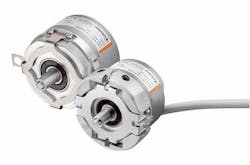The Standard for Gearless Drives Sendix 5873 Motor-Line Encoder
Gearless drives, also known as direct drives, are used in the elevator technology for their high torque at low rotation frequencies and their smooth and silent operation. This leads to specific requirements for the used encoders: short control cycles with high resolution and reliability. Exactly these characteristics make the optical Sendix 5873 singleturn encoders in their Motor-Line version the ideal solution for direct drives.
Highest reliability and optimal travel confort are attributes for every elevator system. The right choice of the sensors is crucial here. The Sendix 5873 Motor-Line encoders convince both in terms of reliability and accuracy.
The tapered shaft with central screw and screw lock ensures a solid connection of the encoder and the drive shaft. These encoders feature a stator or expanding coupling and a tan-gential cable outlet with an optionally pre-assembled connector for simple and optimal installation.
The sturdy construction and the robust Safety-Lock™ design bearing structure are the basis of all Sendix encoders. This bearing structure protects against installation errors as well as against shocks and vibrations in continuous operation. This ensures the long service life of the encoder and its reliable use in the elevator system.
These encoders allow simple and fast commissioning thanks to their plug-and-play feature; they are provided with an elec-tronic data sheet and they allow determining the direct drive rotor position thanks to the absolute singleturn information. This has the advantage to allow positioning the measuring system at a predefined position value.
High encoder accuracy is particularly important for optimal travel comfort. The Sendix 5873 Motor-Line encoders score here with their high control quality. Their fully digital BiSS interface with 21-bit resolution or with 17-bit resolution and additional 2048 SinCos periods per revolution ensure best drive control. Alternative prod-uct variants are also available for converters with SSi interface.
Advantages of the BiSS interface
The BiSS interface is a fully-digital bidirectional connection for absolute measuring systems. Therefore, BiSS is perfectly suited for dynamic axes with very high accelerations, constant speed control and best positioning accuracy possible.
The great advantage of the BiSS interface is its open source pro-tocol for sensors, inverters and drives, offering e.g. high speeds (data rate up to 10 MHz) and a delay compensation for the optimal operation of the drive system. The selection of the components is not imposed by a licensed interface, but only by the requirements of the application, which results in more flexibility and higher cost-efficiency.
>>For more information on this product, click here.
